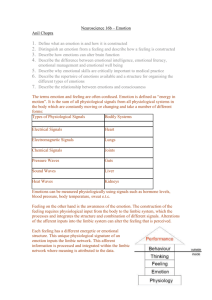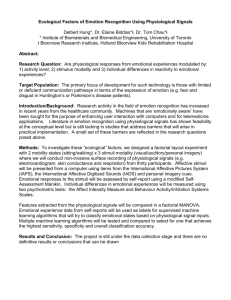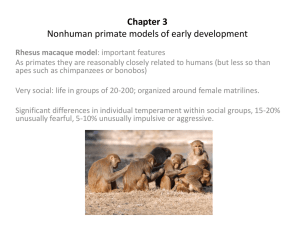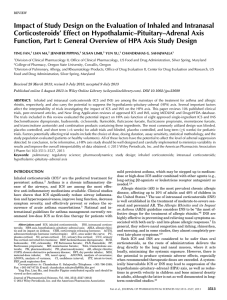Psychosomatic…..
advertisement
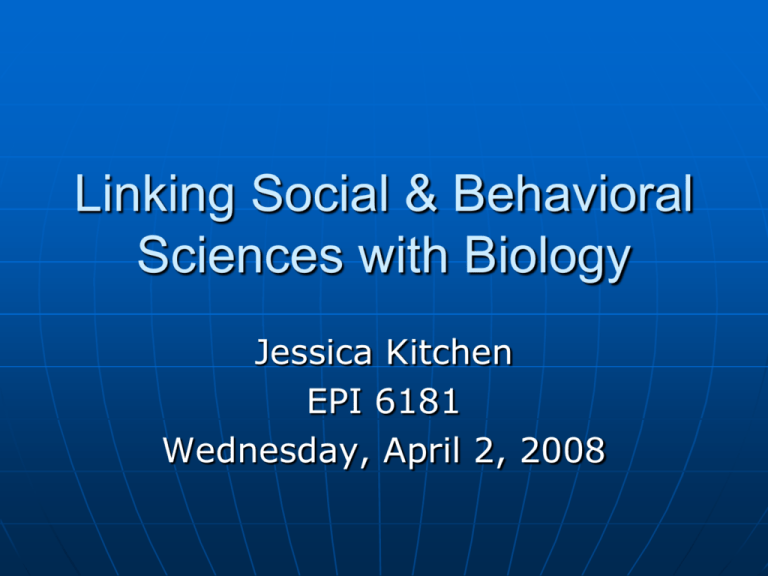
Linking Social & Behavioral Sciences with Biology Jessica Kitchen EPI 6181 Wednesday, April 2, 2008 Overview Description of Psychosomatics History & Background Information Theoretical Approaches Introduction to Mind-Body The Mind The Limbic System The Mind-Body Pathway Hypothalamic-Pituitary-Adrenal Axis (HPA) Sympathetic-Adrenal-Medulla Axis (SAM) Link between Social Status & Physiological Responses Psychosomatics Psychosomatics = A branch of psychiatry that looks at the relationship between emotional and physical health: can feelings & emotions influence physical health? Psychosomatic: ‘psyche’ = soul and ‘soma’ = body Background Information Hysteria • Seen as an “imaginary disease” • In Greek "hysteria" = uterus • Believed the uterus could detach and move throughout the body and hysterical symptoms would emanate from wherever the uterus was lodged By the 17th & 18th centuries the disorder was recognized as being associated with emotional causation History Johann Christian August Heinroth introduced the term ‘psychosomatic’ in 1818 to describe the notion of the mind being capable of enticing both mental and physical illness Sigmund Freud believed that hysterical symptoms resulted from undischarged “memories” connected to “physical and psychological” trauma Franz Alexander tried to establish a link between physiology and Freudian theory (early 20th century) • Emotion leads to physical illness as a result of prolonged overarousal of the autonomic nervous system • Identified that unconscious wishes and infantile desires in the “psychic stimuli” precipitate specific physiological responses History Adolf Meyer introduced psychobiology; emphasized that biological, psychological and social factors all contribute to disease (early 20th century) Cannon (1927) mapped the anatomic and chemical pathways showing how different emotions produced patterns of physiological alterations Pavlov’s dogs demonstrated how visceral somatic organs could respond to mental signals Theoretical approaches Psychophysiology – focuses on how emotion, thoughts etc. modify the physiological response to a stimulus • Selye noted that the stress response is dependent on the nature, the intensity and the individual’s previous experience with that stimulus Psychoanalytical Approaches – noted that stress produces a general effect; attempted to explain why a particular organ was affected in under certain circumstances Theoretical approaches Cognitive Theories – evaluated the links between stress, personality and coping • Martin (1985) identified the alexithymic personality: Inability to identify stressful situations and express emotions, leading to inability to modify and cope Oriental Theories – oriental medicine attempts to restore balance of the “ki” energy, which regulates somatic and psychosocial aspects Other approaches include Sociological, Family Systems theory etc. Introduction Stimulus → Interpretation → Emotional response → Biological response Our physiological reaction to an event is dependent on our perception and interpretation of it • i.e. its predictability, controllability, implications The Mind Three levels: • Awareness - the ability to perceive and respond to stimuli • Conscious mind - our emotional reactions to those stimuli and our intelligent behaviour • Self-conscious mind - knowing that one knows Philosophical problem: the mind has no direct access to the body, mediated through the brain The Limbic System Part of the brain that translates ideas and affects into feelings and emotions Structurally it is composed of an upper and lower circuit, which bridge the neocortex (thinking brain) to parts of the endocrine system Upper circuit appears to be involved in feeling states, while the lower circuit is involved in emotional states specific to survival (flight or fight response) The Limbic System Functions of the limbic system include: • • • • Olfaction Arousal, motivation, etc. Coding in laying down new memories Emotional responses, learning and higher control over exchanges between the body and the external world through emotions • Regulation of homeostasis through the autonomic and endocrine systems Body-Mind Pathway Stimuli are recognized and processed in the neocortex (thinking brain) The limbic system interprets and perceives these stimuli as stressful or not (emotional response) • Suggestion that emotions are stored in body as peptides or receptors, and resulting emotions are due to binding Results in a physiological response through the endocrine system Body-Mind Pathway HPA Axis Hypothalamic-pituitary-adrenal (HPA) axis part of neuroendocrine system, controls reactions to stress and regulates various body processes Amygdala, hippocampus and hypothalamus (lower circuit of limbic system) facilitate activation of HPA axis, which leads to the release of cortisol Prolonged high levels of cortisol have been associated with suppressed immune function, depression and may facilitate central adiposity, a risk factor for coronary heart disease and diabetes (Cohen S. et al. 2006) HPA Axis SAM Axis Sympathetic-adrenal-medulla (SAM) axis part of the sympathetic nervous system, responsible for initiating fight or flight response Stress stimulates nerves that directly innervate the adrenal medulla, releasing norephinephrine and epinephrine Results in increased heart rate, increased blood flow to muscles and diverted blood flow from digestive system, inhibited salivary flow, dilated pupils etc. SAM Axis Link between Social Status & Physiological Responses Sapolsky et al. (1997) showed baboons of higher rank had greater cortisol suppression, suggesting more effective glucocorticoid negative feedback Steptoe & Marmot noted that cardiovascular reactivity is generally greater in lower SES individuals (confounding by stressor characteristics, or hostility, etc.?) Lupien, et al. (2000) showed lower SES children had higher salivary cortisol levels than higher SES children Cohen et al. (2006) found higher SES was associated with lower levels of cortisol and epinephrine, independent of race, age, gender and body mass Link to Disease Chronic stress → chronic HPA & SAM activation: • May increase other risk factors (abdominal obesity, immune functioning, insulin resistance) • May disrupt normal homeostatic processes resulting in abnormal physiological functioning • May have long-term effects on the immune and cardiovascular systems, increasing risk of disease and leading to more rapid progression once established (Adler, N. & Ostrove, J, 1999)
